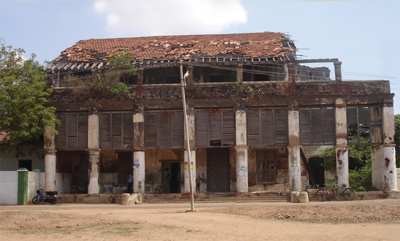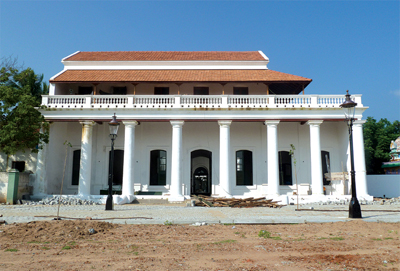|
The Heritage Conservation Committee (HCC), appointed by the Government of Tamil Nadu following a specific directive of the High Court of Madras, completed one year in July 2011. The occasion warranted a celebration – and it was not long in coming when the Committee was in a position to report its first successful representation. This was to the Chennai Metro Rail Limited regarding the alignment of railway lines and stations that are planned to be in close proximity to heritage buildings in the city. The CMRL has stated it would go along with the HCC’s advice. This is definitely a positive development, but the general working of the Committee leaves much to be desired. A year of functioning may be the right time to critically evaluate what it has done.

The Governor's Bungalow as it was (above) when INTACH Pondicherry began working on it three years ago, and as it is today when its restoration nears completion. (Photographs courtesy: INTACH Pondicherry.)
 |
When the High Court passed its judgement, it had on hand a list of a little over 400 heritage buildings. This was a list prepared for an entirely different matter, a case involving outdoor hoardings and was put together mainly for the purpose of enumerating structures that ought not to be hidden behind hoardings. It, therefore, largely listed heritage structures on arterial roads and did not look at buildings that are on side streets. But it was still a list, and when the High Court ordered that a Heritage Conservation Committee ought to be formed, it also added that these listed buildings had to come under the Committee’s purview.
The Committee when formed largely comprised bureaucrats who toed the official line. It took its own time to send out letters to the owners of the listed properties. It is reliably learnt that several owners of heritage properties never received the letter. The Committee has visited just a few of the heritage sites that were listed. Not even those sites where restoration or major repair work is going on have been visited. It is, therefore, not in touch with what is happening in most cases of threats to heritage buildings.
Taking advantage of the delay in communication, some owners have gone ahead and demolished their buildings. The Government was the biggest culprit, for, in its hurry to build the new (and now unwanted) Assembly, it destroyed five listed buildings, with no explanations being asked. Others were not so lucky. It is reliably learnt that the Church of South India, which demolished the Bible Society Building on Memorial Hall Road, was asked to come up with plans to build a structure aligned to what was done away with. That some action has been taken is small satisfaction, for the old structure is no longer there.
A bigger success was in getting those in charge of St Teresa’s Church to give up ideas of demolition. No action was, however, taken in the case of Anderson’s Church on NSC Bose Road, where extensive ‘renovation’ work of its interior was undertaken, without any competent authority overseeing the progress. This is also happening elsewhere in the city too.
The one and only communication that the Committee ever sent out was vague in the extreme. Beyond stating that the owner could not demolish or alter the structure, the letter did not have anything constructive to say about what could be done with the buildings. This tied the hands of the owners and lack of maintenance efforts has ensured that at least two heritage structures – the GPO on Rajaji Salai and the Madrasa-E-Azam on Mount Road – have partially collapsed. To what purpose is any action now on the matter when the damage has been done? Added to this is the sheer apathy of other Government departments. It is now understood that the Committee is sitting in judgement over whether the historic Mint on the eponymous street needs to be demolished. The Government, it is believed, is all for it.
It is, thus, in the light of the rather lacklustre performance that the successful representation to Metro Rail appears a major breakthrough. The Committee has managed to get the Metro Rail to prepare revised drawings and plans for its stations at locations near the Law College, Higginbotham’s and a couple of other places. It is significant, however, that none of these revised designs has been made public and we have only the Committee’s word for it.
Taken overall, the performance of the Committee is below par. But, as we still have a significant bit of heritage left in the city, any improvement by the Committee in its functioning will go a long way towards saving what has survived thus far.
|